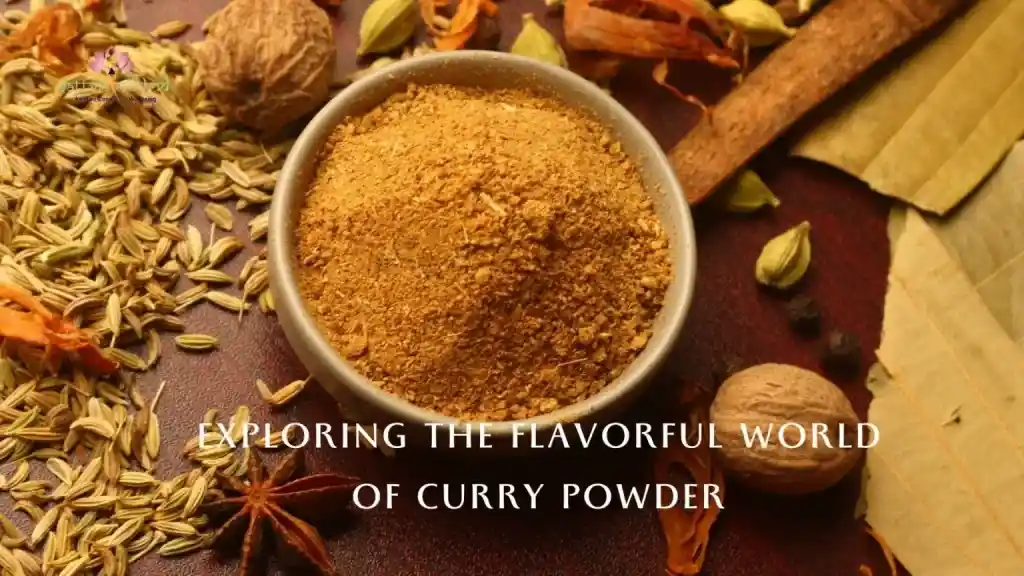Step into the vibrant and aromatic world of curry powder as we embark on a journey to uncover its intriguing origins, versatile uses, and various health benefits. Bursting with a symphony of exotic flavors, curry powder has become a staple in kitchens worldwide, adding depth and complexity to a wide range of dishes.
With its roots tracing back to the Indian subcontinent, curry powder encapsulates the essence of traditional Indian cuisine, offering a tantalizing blend of aromatic spices, such as turmeric, cumin, coriander, fenugreek, and more. But its influence extends far beyond India’s borders, becoming a beloved ingredient in global cuisine.
From hearty curries to flavorful stews, rice dishes, and marinades, curry powder opens a world of culinary possibilities. Its unique blend of spices lends a distinct flavor profile that can transform even the simplest of dishes into a gastronomic delight.
While the tantalizing taste of curry powder alone is reason enough to include it in your recipes, its health benefits are equally compelling. Rich in antioxidants, anti-inflammatory compounds, and potential immune-boosting properties, curry powder has been linked to promoting heart health, aiding digestion, and even reducing the risk of chronic diseases.
So buckle up and get ready to discover the captivating allure of curry powder, as we delve into its rich history, explore its versatile uses, and unlock the secrets behind its potential health benefits.
The origins and history of curry powder
The journey of curry powder begins in the Indian subcontinent, where it has been an integral part of culinary traditions for centuries. The term “curry” itself is derived from the Tamil word “kari,” which means sauce. Initially, it referred to a variety of dishes featuring a combination of spices and herbs cooked in a sauce. As trade routes expanded, these spice blends began to make their way beyond India, influencing cuisines across the globe. The Western interpretation of “curry” as a singular spice blend is a more modern adaptation of these rich culinary practices.
Historically, spices have played a crucial role in Indian culture, not just for flavor but also for their medicinal properties. Ancient texts, such as Ayurveda, documented the health benefits of various spices, including those that form the basis of curry powder. Over time, as Indian cuisine evolved, so did the recipes for these spice blends, leading to the creation of curry powder as we know it today. British colonialism further popularized curry in the West, introducing it to European palates and inspiring the creation of pre-packaged curry powders in the 18th and 19th centuries.
As curry powder gained global traction, it began to evolve, absorbing influences from various cultures. The adaptability of curry powder allowed it to be embraced by diverse culinary traditions, from Thai to Caribbean. This cross-cultural exchange not only enriched the recipes but also solidified curry powder’s status as a beloved ingredient worldwide. Today, it is celebrated for its ability to bring warmth and complexity to dishes, representing a fascinating blend of history, culture, and flavor.
What is curry powder made of?
Curry powder is not a single spice but rather a complex blend of various spices, each contributing to its distinct flavor profile. The specific combination can vary widely, but some core ingredients are commonly found in most blends. Turmeric is often the star ingredient, providing the characteristic yellow color and earthy flavor. Cumin adds warmth and a nutty taste, while coriander contributes a hint of citrusy brightness. Fenugreek, black pepper, and sometimes chili powder or paprika are also included to add depth and heat.
Beyond these foundational spices, curry powder may contain other ingredients such as garlic powder, ginger, cinnamon, and mustard seeds, depending on regional preferences and individual recipes. This diversity means that there isn’t a definitive formula for curry powder; instead, it reflects the culinary heritage of the area from which it originates. For instance, North Indian blends may be richer and creamier, while South Indian versions may lean toward spiciness and tang.
The quality of the spices used in curry powder can significantly affect its flavor. Freshly ground spices tend to offer a more vibrant taste compared to pre-packaged blends that may have lost potency over time. For those who are adventurous in the kitchen, experimenting with different ratios and additional spices can lead to a personalized curry powder that perfectly suits one’s palate.
Popular uses of curry powder in different cuisines
Curry powder is incredibly versatile, making it a staple in many culinary traditions around the world. In Indian cuisine, it is perhaps most famously used in curries, which can range from creamy coconut milk-based dishes to spicy tomato-based sauces. Dishes like chicken tikka masala or vegetarian chana masala showcase how curry powder can elevate the taste of proteins and legumes alike. Additionally, it is often used to season rice, lentils, and even marinades, making it an essential component in many Indian households.
Outside of India, curry powder has found its way into various cuisines, each adapting the spice blend to create unique dishes. In Thai cooking, for example, curry powder is often combined with coconut milk and fresh herbs to create rich curries that are both fragrant and flavorful. The famous Thai yellow curry showcases how the foundation of curry powder can be enhanced with fresh ingredients like lemongrass and basil, resulting in a dish that is distinct yet rooted in the same spice traditions.
In Caribbean cuisine, curry powder is a key ingredient in dishes like curry goat and chicken curry, reflecting the region’s historical ties to Indian laborers brought over during colonization. Here, the spice blend is often used in conjunction with other local flavors, such as allspice and Scotch bonnet peppers, to create a fiery and aromatic dining experience. This adaptability across cultures exemplifies how curry powder can transcend boundaries, bringing a taste of the world into everyday meals.
Health benefits of curry powder
Curry powder is not just a flavor enhancer; it also comes with a host of health benefits that make it a valuable addition to your diet. One of the most notable components of curry powder is turmeric, which contains curcumin, a compound known for its anti-inflammatory and antioxidant properties. Regular consumption of turmeric has been linked to reduced inflammation in the body, potentially lowering the risk of chronic diseases such as heart disease and arthritis. This makes curry powder a beneficial ingredient for those seeking to maintain overall health.
In addition to turmeric, the spices in curry powder can aid digestion. Ingredients like cumin and coriander have been traditionally used in various cultures to support digestive health. They can help alleviate bloating and improve gut health, making curry powder a great addition to meals for those looking to enhance their digestive function. Moreover, certain spices in curry powder, such as ginger, have been shown to help with nausea and other digestive discomforts.
Furthermore, curry powder is rich in antioxidants, which combat oxidative stress in the body. This can lead to a strengthened immune system, promoting overall wellness. Some studies have even suggested that the consumption of spices found in curry powder may contribute to brain health, potentially protecting against neurodegenerative diseases. While more research is needed, the potential benefits associated with curry powder make it a compelling reason to incorporate this spice blend into your culinary repertoire.
Different types of curry powders and their flavors
Curry powder is a broad term that encompasses a variety of blends, each with its unique flavor profile and characteristics. Indian curry powder is perhaps the most recognized, often being a blend of spices that includes turmeric, cumin, coriander, and fenugreek. Within India, regional variations exist; for instance, South Indian curry powders may incorporate more heat and coconut, while North Indian blends might focus on a creamier texture with richer spices.
Moving beyond Indian cuisine, Thai curry powders often include ingredients like lemongrass, galangal, and kaffir lime leaves, resulting in a fresher and more fragrant flavor. Thai yellow curry powder, for instance, is typically milder and sweeter than its green or red counterparts, making it versatile for various dishes, including seafood and vegetables. The use of coconut milk in these curries adds a unique richness that differentiates them from Indian styles.
In Caribbean cuisine, curry powder can be quite different, often featuring a more robust flavor with the inclusion of allspice and Scotch bonnet peppers. This variety is designed to match the bold flavors of the local ingredients and cooking styles. Each version of curry powder tells a story of its origins, reflecting the culinary practices and cultural influences of the regions they come from, making the exploration of these different types a delightful journey for any food lover.
How to cook with curry powder
Cooking with curry powder can be an exciting way to experiment in the kitchen, as it offers a multitude of flavors that can enhance a variety of dishes. One of the simplest methods to incorporate curry powder is by seasoning your proteins before cooking. For instance, marinating chicken or tofu in a mixture of yogurt and curry powder can result in tender and flavorful dishes when grilled or roasted. The spices penetrate the meat, offering a depth of flavor that pairs beautifully with rice or bread.
Another effective way to use curry powder is in stews and soups. When sautéing onions and garlic at the beginning of your cooking process, adding curry powder can create a fragrant base that infuses the entire dish with flavor. Whether making a lentil soup, vegetable stew, or a hearty chicken curry, incorporating curry powder early in the cooking process allows the spices to bloom, enhancing the overall taste.
Finally, curry powder can also be sprinkled onto roasted vegetables or mixed into dips and sauces. A simple yogurt dip with curry powder, garlic, and lemon juice can serve as a delightful accompaniment to appetizers or a refreshing dressing for salads. Roasting vegetables with olive oil and curry powder can transform them into a flavorful side dish that complements many main courses. The versatility of curry powder makes it an excellent ingredient to keep on hand for various culinary adventures.
Homemade curry powder recipes
Creating your own curry powder at home can be a rewarding experience, allowing you to customize the flavors to suit your palate. A basic homemade curry powder recipe may include equal parts turmeric, cumin, and coriander, along with smaller quantities of fenugreek and black pepper. This foundational blend can serve as a springboard for experimentation. For those who prefer a spicier kick, adding chili powder or crushed red pepper flakes can elevate the heat level.
For a more aromatic blend, consider incorporating spices like cardamom and cinnamon. A recipe that combines one tablespoon each of turmeric, cumin, coriander, and fenugreek, with half a tablespoon of cinnamon and cardamom, can create a sweet and fragrant curry powder perfect for dishes like desserts or lighter curries. Toasting the spices lightly in a dry skillet before grinding them can also enhance their flavors and aromas.
If you enjoy a smoky flavor, you could create a smoked curry powder by adding smoked paprika to your blend. A recipe that includes two tablespoons of turmeric, one tablespoon of cumin, one tablespoon of coriander, and one tablespoon of smoked paprika can add a unique twist to your dishes. Experimenting with different spices and ratios will not only yield a personalized curry powder but also deepen your understanding of how each spice contributes to the overall flavor profile.
Buying and storing curry powder
When purchasing curry powder, quality is key. Opt for whole spices whenever possible and grind them at home for the freshest flavor. If buying pre-packaged curry powder, look for brands that source their spices carefully and use minimal preservatives. Always check the expiration date, as spices lose their potency over time. Some specialty stores offer a variety of curry powders from different regions, allowing you to explore unique blends that may not be available in your local grocery store.
Once you’ve acquired your curry powder, proper storage is essential to maintain its flavor and aroma. Store it in an airtight container in a cool, dark place away from direct sunlight and moisture. A spice drawer or a pantry shelf works well, but avoid keeping it near the stove or sink, where heat and humidity can degrade its quality. Ground spices generally have a shelf life of about six months to a year, while whole spices can last much longer if stored correctly.
If you find yourself with a surplus of curry powder, consider vacuum sealing portions of it for longer storage. You can also create smaller spice blends by mixing your curry powder with other spices like cumin or coriander, tailoring it for specific recipes. By taking these steps, you can ensure that your curry powder retains its vibrant flavor and continues to elevate your culinary creations.
Exploring the versatility of curry powder
Curry powder is a remarkable ingredient that offers a rich tapestry of flavors, history, and health benefits. As we have explored, its origins are steeped in tradition, with roots in Indian cuisine that have spread across the globe. Each blend tells a story, reflecting the diverse cultures and culinary practices that have embraced this spice. The versatility of curry powder allows it to be used in various dishes, from hearty stews to light salads, making it a cherished staple in kitchens worldwide.
Beyond its culinary applications, curry powder’s health benefits make it a valuable addition to any diet. Rich in antioxidants and anti-inflammatory compounds, it has the potential to support overall health and well-being. Whether you are using it to enhance a beloved recipe or experimenting with new flavors, curry powder opens the door to a world of culinary creativity.
As you embark on your culinary adventures with curry powder, don’t hesitate to explore different types, create your own blends, and share your discoveries with friends and family. This spice blend is more than just a flavor enhancer; it is a celebration of history, culture, and the joy of cooking. So, step into the flavorful world of curry powder and let it inspire your next meal!
Ready to spice up your cooking with Curry Powder?
Discover our brand-new cookbooks packed with mouthwatering curry recipes that will take your taste buds on a flavorful journey. The Sattvic Method Company provides a whole range of cookbooks that has you covered from breakfast to feast. Explore them today and bring the magic of curry into your kitchen!
Click on the link to purchase the cookbooks.




